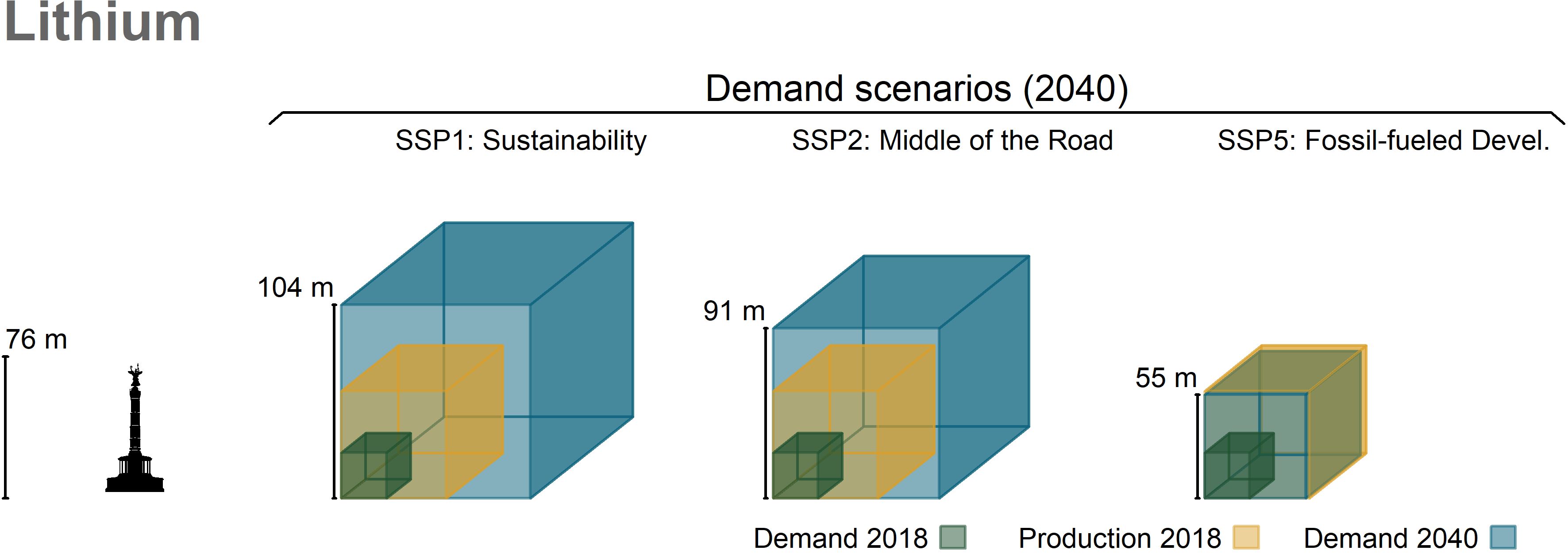Project
Ensuring Germany has a secure supply of raw materials is an essential precondition for its industry’s international competitiveness. New megatrends and innovation breakthroughs in technology development can lead to unexpected surges in demand – for instance in high-tech raw materials – and therefore to supply bottlenecks and at least temporary spikes in raw material prices.
To better estimate potential raw material supply risks and price, the research project “Raw Materials for Emerging Technologies 2021“ estimates demand for the year 2040. This study, prepared by Fraunhofer ISI and Fraunhofer IZM, updates the studies from 2009 and 2016. The approximately five-year update is part of DERA’s resource monitoring.
Tabbed contents
Results
The first step was to compile a list of approx. 250 emerging technologies. This compilation was based, among other things, on an industry workshop held in November 2019. Emerging technologies are industrially exploitable technical abilities that trigger revolutionary boosts to innovation that go far beyond the boundaries of individual economic sectors. Ten emerging technologies were selected from this list, for which detailed technology analyses were provided. The criteria for selecting the technologies analyzed were the respective state of the art, market maturity and recycling potential. In addition, 23 technology synopses from the preceding project were revised and updated. The year 2018 was chosen as the reference year.
Three different scenarios explored what demand impulses for raw materials are triggered by the future industrial utilization of emerging technologies and on which raw materials such innovations are particularly dependent.
Depending on the scenario, the analysis shows that the demand of emerging technologies for a total of eleven metals could be significantly higher in 2040 than today’s production levels. This concerns, e.g. the demand for lithium, which could be 5.9 times higher than current production levels due to the growing demand for batteries for electric mobility applications. Scandium, which is needed for hydrogen technology, could even exceed current production by a factor of 7.9. In an age of increasing digitization, there will also be a higher future demand for platinum and ruthenium, which are important for producing hard disk drives. Future demand for these two metals could exceed current production by a factor of 4.3 and 19, respectively.
This could result in new supply challenges for those raw materials that are produced in only a few countries and therefore show a high concentration of supply on the market. In addition to the platinum group elements, cobalt, which is needed for lithium-ion batteries and rare earth metals, which are used in electric mobility and wind turbines also display a high concentration of supply.
The results of the study were presented at a virtual event “Raw Materials for Emerging Technologies 2021“ on July 1, 2021. The video recording of the event is available here.
Publications
- Marscheider-Weidemann, F.; Langkau, S.; Baur, S.-J.; Billaud, M.; Deubzer, O.; Eberling, E.; Erdmann, L.; Haendel, M.; Krail, M.; Loibl, A.; Maisel, F.; Marwede, M.; Neef, C.; Neuwirth, M.; Rostek, L.; Rückschloss, J.; Shirinzadeh, S.; Stijepic, D.; Tercero Espinoza, L.; Tippner, M. (2021): Rohstoffe für Zukunftstechnologien 2021. – DERA Rohstoffinformationen 50: 366 p., Berlin.
- Presentation “Results of the study: Raw materials for emerging technologies 2021“ on 01.07.2021 (online event).
Previous studies
- Marscheider-Weidemann, F.; Langkau, S.; Hummen, T.; Erdmann, L.;Tercero Espinoza, L.; Angerer, G.; Marwede, M. & Benecke, S. (2016): Rohstoffe für Zukunftstechnologien 2016. DERA Rohstoffinformationen 28: 353 p., Berlin.
- Marscheider-Weidemann, F.; Langkau, S.; Hummen, T.; Erdmann, L.; Tercero Espinoza, L.; Angerer, G.; Marwede, M. & Benecke, S. (2016): Summary - Raw materials for emerging technologies 2016. DERA Rohstoffinformationen 28: 13 p., Berlin.
- Angerer, G.; Erdmann, L.; Handke, V.; Lüllmann, A.; Marscheider-Weidemann, F.; Marwede, M.; & Scharp, M. (2009): Rohstoffe für Zukunftstechnologien. Studie im Auftrag des Bundesministeriums für Wirtschaft und Technologie: 383 p.; Fraunhofer-Institut für System- und Innovationsforschung ISI sowie Institut für Zukunftstechnologie-bewertung IZT gGmbH. Karlsruhe-Berlin.
more
Duration
September 2019 - March 2021
Clients
- German Mineral Resources Agency (DERA) at the Federal Institute for Geosciences and Natural Resources (BGR)
Partners
- Fraunhofer IZM, Berlin
